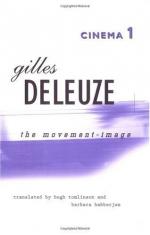
|
| Name: _________________________ | Period: ___________________ |
This test consists of 15 multiple choice questions and 5 short answer questions.
Multiple Choice Questions
1. What nationality was Kurosawa?
(a) Japanese.
(b) German.
(c) Russian.
(d) Korean.
2. What is the name of the form in which things move from action to situation.
(a) SAA.
(b) AAS.
(c) ASA.
(d) SAS.
3. What does a sensory-motor link use?
(a) Impulse-image.
(b) Action-image.
(c) Situation-image.
(d) Perception-image.
4. What was Herzog's first obsessive theme?
(a) Pathetisation.
(b) Synsign.
(c) Kurosawa.
(d) Sublime action.
5. Keaton uses a large gap to reflect what kind of action?
(a) Fast.
(b) Comic.
(c) Dramatic.
(d) Slow.
6. What is the second pole of action-image?
(a) Firstness.
(b) Binomial.
(c) Behavior.
(d) Genetics.
7. A complex entity can be which of the following?
(a) An item used off screen.
(b) Person, thing, character.
(c) Character or person.
(d) Characters who don't come on-screen.
8. What is the first of five traits of the new image, as designated by Deleuze?
(a) Thirdness.
(b) Firstness.
(c) Dispersive.
(d) ASA.
9. Where was Fuller from?
(a) USA.
(b) Japan.
(c) France.
(d) Germany.
10. Deleuze claims that impression links situation with which other element?
(a) Action.
(b) Reaction.
(c) Impulse.
(d) Perception.
11. What is the name of the form in which things move from situation to action?
(a) AAS.
(b) SAS.
(c) SAA.
(d) ASA.
12. According to Pierce, nothing is beyond which of the following?
(a) Secondness.
(b) Firstness.
(c) Deliberation.
(d) Thirdness.
13. Which film is used as an example by the filmmaker Snow?
(a) The Hills.
(b) The City.
(c) The San Joaquin Valley.
(d) The Central Region.
14. Who is the first man Deleuze calls a cinematic master of realism?
(a) Eisenstein.
(b) Griffith.
(c) Stroheim.
(d) Epstein.
15. What kind of director does Deleuze believe to have the most difficulty with naturalism?
(a) German.
(b) Pre-war French.
(c) American.
(d) Soviet.
Short Answer Questions
1. What word does Pierce associate with "Secondness"?
2. What kind of film does Deleuze say frees any-space-whatevers from human coordinates?
3. What is the first pole of action-image?
4. What is the name of Herzog's film with a Bavarian landscape?
5. How does Deleuze describe the difference between Bunuel and Stroheim?
|
This section contains 324 words (approx. 2 pages at 300 words per page) |

|




